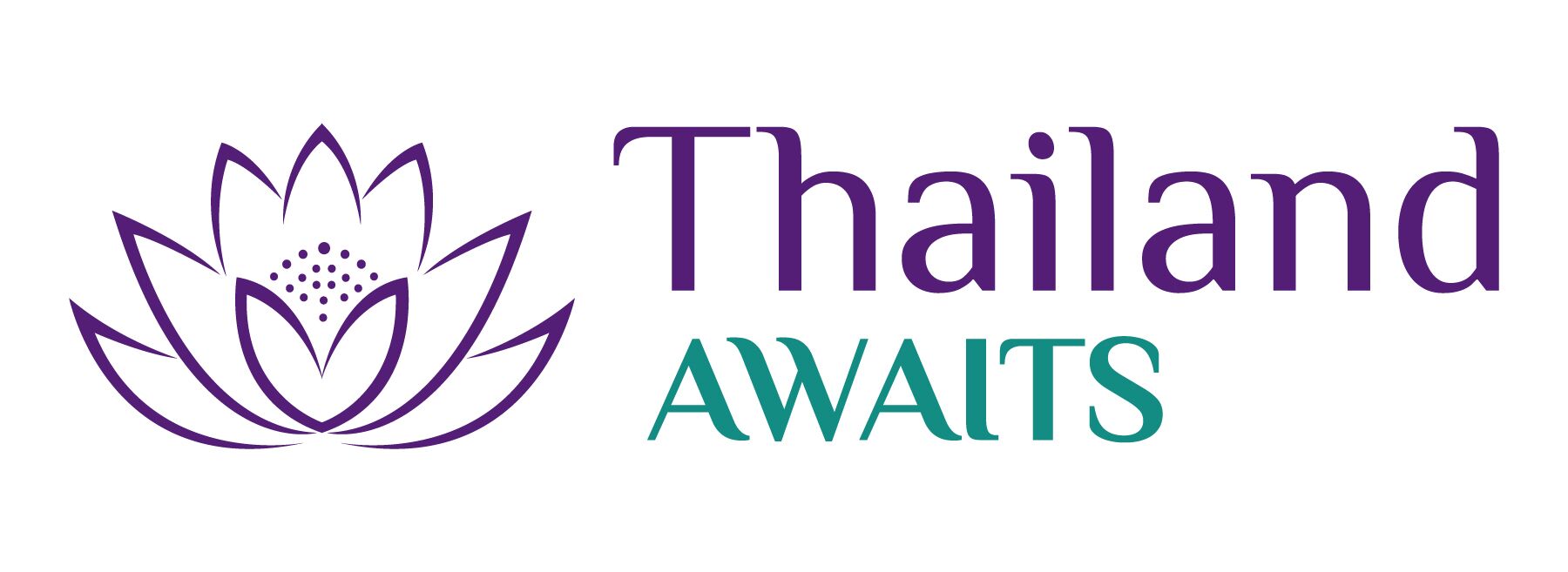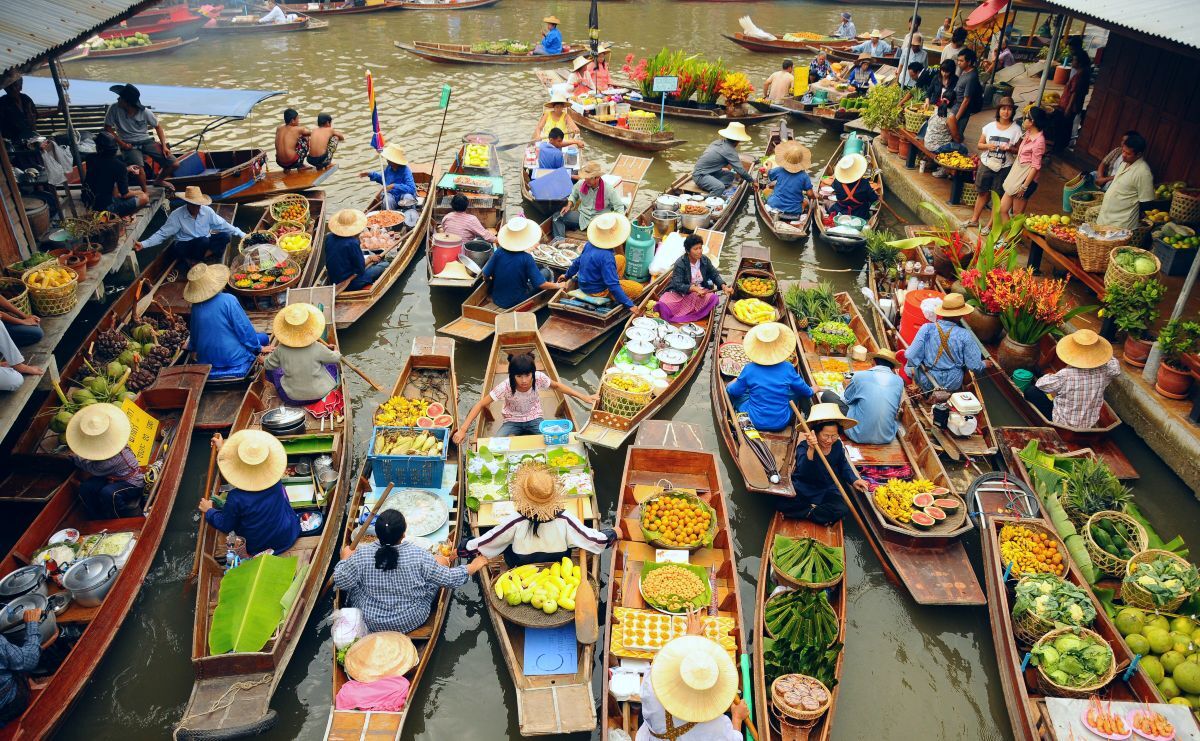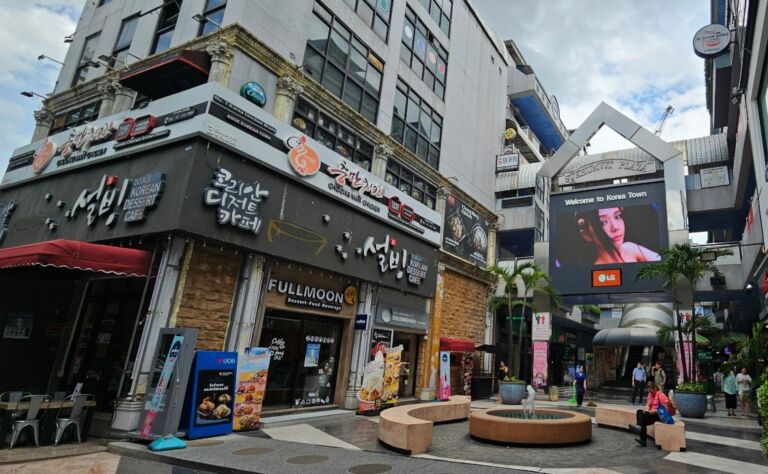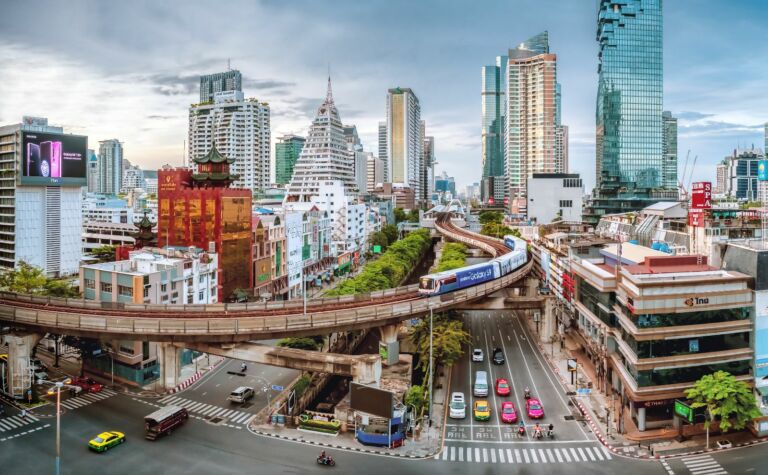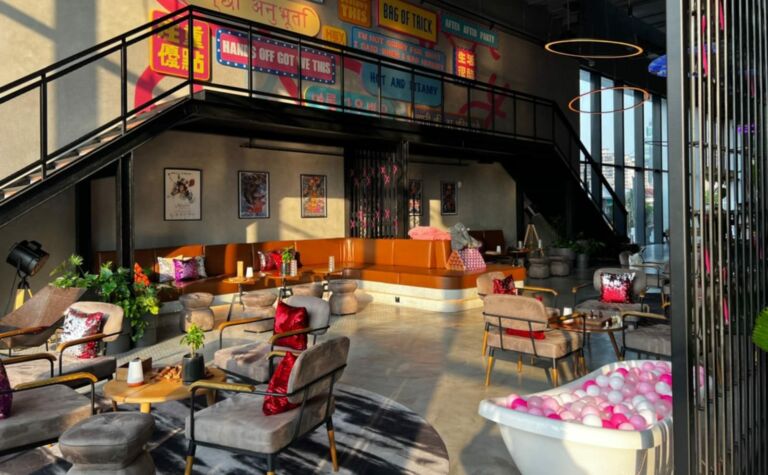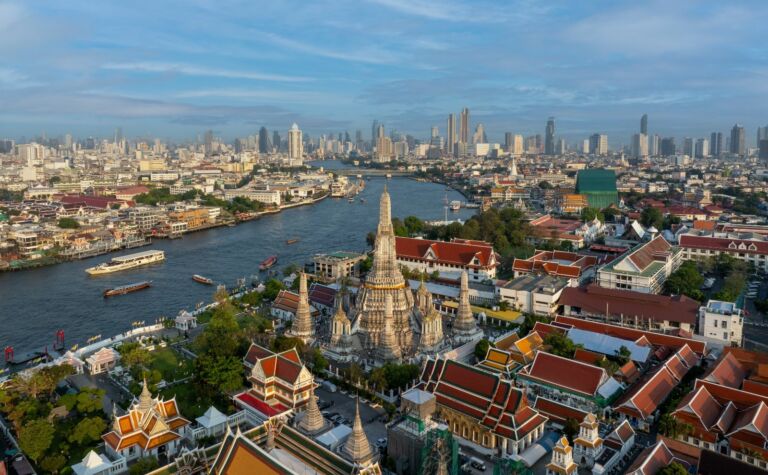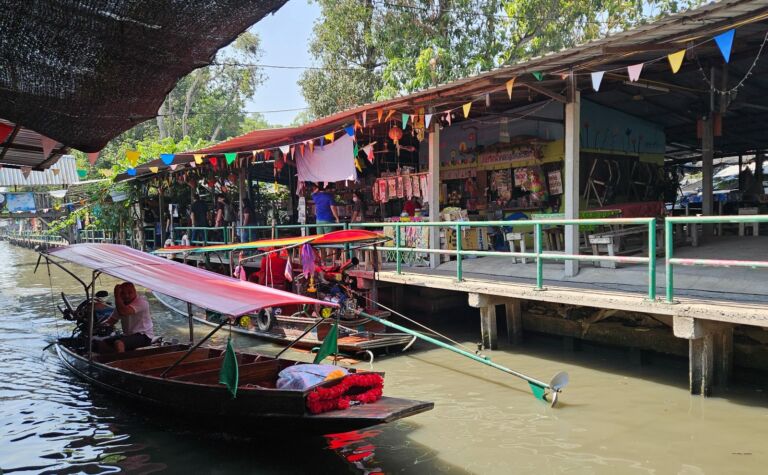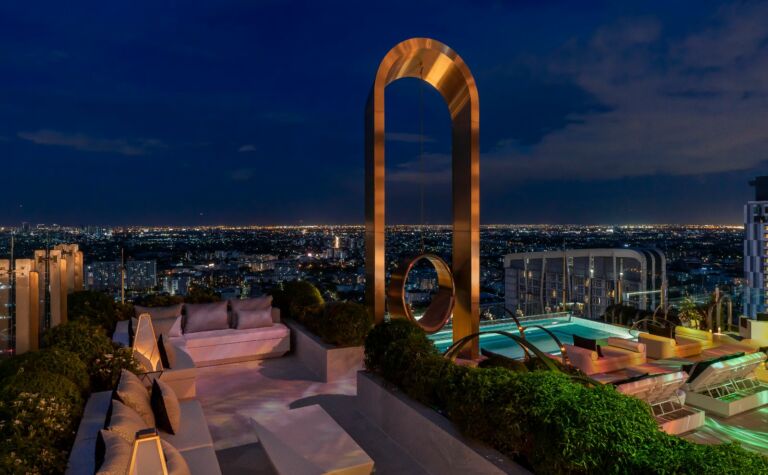Touring Bangkok’s Floating Markets: Hotspots and Local favourites
Bangkok’s floating markets are on most Thailand bucket lists, but with some being tourist hotspots and others still serving as genuine local trading posts, choosing the right one can be tricky. As a Bangkok local who’s spent years exploring these markets, I’m going to share both the famous spots and the hidden gems that most tourists never hear about.
This page contains affiliate links. Please see our disclosure policy for more details.
Though their numbers have dwindled from hundreds to less than twenty, each surviving market tells its own unique story. Some have become tourist attractions, while others remain authentic trading posts where locals still do their weekly shopping. Trust me – visiting at least one of these markets will give you a glimpse into Thailand that you won’t find anywhere else
Bangkok is well-known as a shopper’s paradise, with markets being huge draw cards. There are wet markets, dry markets, weekend and night markets. However, one style of market has been operating in Thailand for centuries, and that is the floating market.
Let me take you back in time to understand how these fascinating markets came to be, and what makes them so special today.
The Story Behind Bangkok’s Floating Markets
Back in the day, before roads were built, the Chao Phraya River was the main artery of Thailand, and trade of anything and everything was conducted on the river. Every morning, farmers would load their boats with fresh produce, pushing off from their riverside homes to meet traders and buyers in the middle of the river.
Many people lived in houses right on the river, and their only mode of transport was a boat. Locals conducted all business in the middle of the river, boat to boat. This activity earned Bangkok the nickname ‘the Venice of the East.’ And while today’s city looks very different, you can still catch glimpses of this magical past at our floating markets.
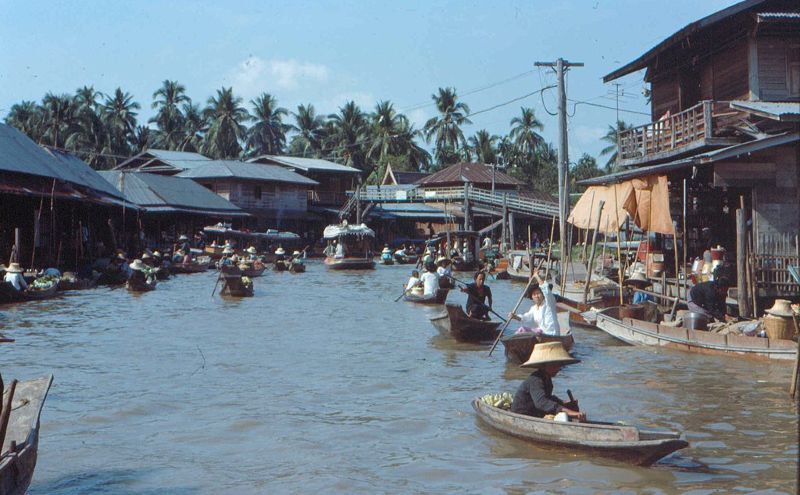
The Chao Phraya’s network of tributaries (known locally as Khlongs) created a vast water highway system throughout Bangkok. These waterways connected countless communities, with people living along the banks and using the water as their daily commute to trade and socialize.
But Bangkok’s march toward modernization in the 20th century brought dramatic changes. As the city expanded, many of these historic Khlongs were filled in to make way for roads.
Gradually, the river became less popular as a place to conduct business as people began to live and work inland. Traditional floating markets started disappearing one by one, replaced by land-based markets and, eventually, modern shopping centers.
What are Floating Markets like Today?
While Bangkok has evolved into a modern metropolis, its floating markets tell two different stories. Some have transformed into vibrant tourist attractions, offering a carefully crafted glimpse of old Thailand.
Others remain authentic community hubs where locals still do their weekly shopping, gossip with neighbours, and grab their favorite boat noodles for breakfast.
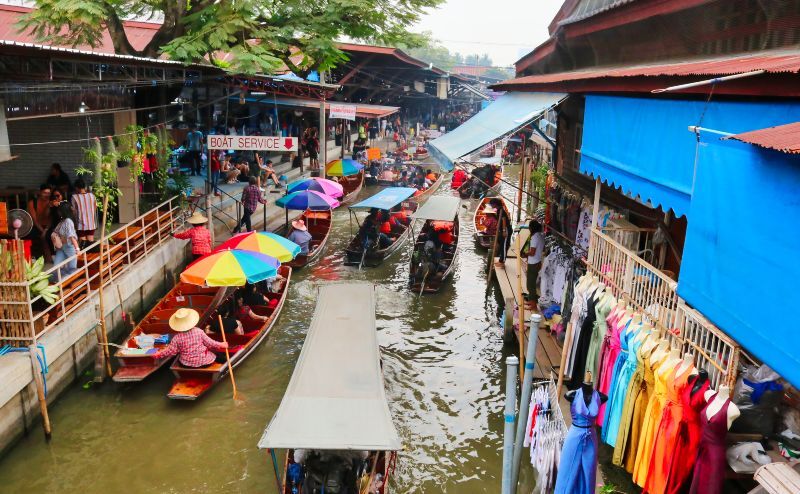
Today’s floating markets might not exactly match those postcard images you’ve seen. While you’ll still experience the joy of traveling by boat and shopping from waterside vendors, most markets now operate from fixed structures along the riverbanks rather than entirely from boats.
But don’t let this discourage you – the atmosphere, the aromas of fresh-cooked food, and the bustle of river life still create an experience you won’t find anywhere else in modern Bangkok.
The Most Popular Floating Markets for Tourists
There’s one market that still operates in the traditional way – boats meeting in the middle of the canal to trade – and that’s the famous Damnoen Saduak. It’s first on my list of the most popular tourist markets, and while these well-known spots may be more commercial than their historical counterparts, they each offer something special.
Let me walk you through the three markets you’ve probably seen in travel magazines and Instagram feeds. Yes, they’re touristy, but they’re also carefully preserved pieces of Thai culture that showcase our waterborne heritage.
Having taken countless friends and family to these markets over the years, I can tell you they’re worth visiting – you just need to know what to expect.
Damnoen Saduak Floating Market
If you’ve ever seen a photo of a Thai floating market – wooden boats piled high with tropical fruits, elderly vendors in traditional hats paddling through narrow canals – it was probably taken at Damnoen Saduak.
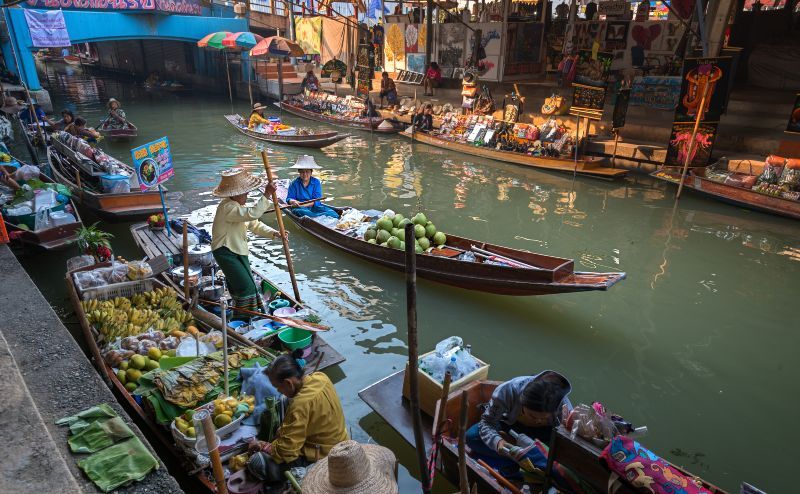
This is Thailand’s most famous floating market, and the only one that still operates in that classic, postcard-perfect way.
Here’s what makes it special: you’ll hop on a long-tail boat and glide through a maze of canals, where vendors in traditional boats paddle up alongside you. They’ll offer everything from fresh mangoes and durian to boat noodles and coconut ice cream. The smell of grilled seafood and fresh coffee mingles with the calls of vendors – it’s sensory overload in the best possible way.
Fair warning: as the most famous floating market in Thailand, it can get pretty crowded, especially mid-morning. You might find yourself in a bit of a boat traffic jam! But don’t let that put you off – it’s part of the experience. Just lean back in your boat, camera ready, and enjoy the show.
What You Need to Know
Damnoen Saduak floating market is actually 100km southwest of Bangkok and is best to do as a half-day tour. See our recommendations below.
When: Opens daily (except major holidays) from 7am to 12pm. Pro tip: arrive by 8am to beat the crowds and get the best photos.
Where: Damnoen Saduak District, Ratchaburi (map) – about 100km southwest of Bangkok.
How: Your best options are:
- Join a half-day tour (perfect if you’re short on time)
- Book a guided tour (recommended for first-timers)
- Hire a private driver (more flexible but pricier)
Bonus Experience: Consider combining your visit with a traditional long-tail boat tour of the local canals – it’s a great way to see the neighborhood’s waterside life.
Amphawa Floating Market Bangkok
While Damnoen Saduak shows you Thailand’s floating markets of the past, Amphawa offers something different: a glimpse into how modern Thais enjoy their riverside heritage.
This is Bangkok’s second most famous floating market, but it has a completely different vibe – it’s an afternoon and evening affair that comes alive as the sun starts to set.
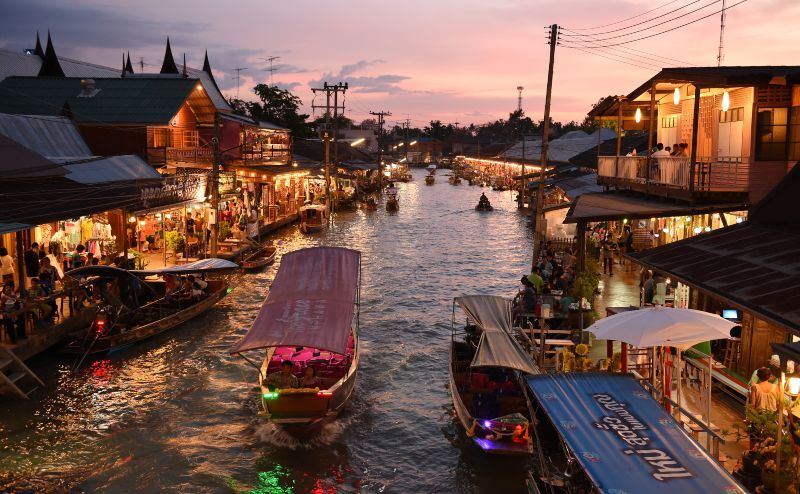
What makes Amphawa special is its atmosphere. Wooden shops and restaurants line both sides of the canal, with boats moored alongside serving up some of the best seafood you’ll find anywhere in Thailand.
Here’s my insider tip: make it an overnight trip. The market is about 80km from Bangkok in Samut Songkram province, and there’s some lovely riverside accommodation nearby.
The market experience here is different from Damnoen Saduak – instead of paddling vendors, you’ll find a more relaxed scene where you can stroll along the waterfront, take evening boat rides, and feast on seafood as the sun sets.
What You Need To Know
The market experience here is different from Damnoen Saduak – instead of paddling vendors, you’ll find a more relaxed scene where you can stroll along the waterfront, take evening boat rides, and feast on seafood as the sun sets.
When: Friday to Sunday (excluding holidays) from 4pm to 9pm. Pro tip: arrive around 4pm to see the market come to life, then stay for dinner and the evening atmosphere.
Where: Amphawa District, Samut Songkhram 75110, Thailand (map) – about 80km from central Bangkok
How: Your options include:
- Book a private driver (most flexible, can be arranged in advance)
- Join an evening tour (includes transport and guide)
- Take a taxi (best to arrange return trip in advance)
Bonus: If you’re staying overnight, ask your accommodation about firefly boat tours – they’re magical during the crescent moon phase!
Local Floating Markets: Where Bangkok Residents Shop
Want to experience floating markets the way locals do? While the tourist markets offer grand spectacles, these smaller markets serve Bangkok residents who still shop and eat by the water. They’re less crowded, more authentic, and often more affordable.
Don’t worry about being an outsider – visitors are welcome, and you’ll get a genuine glimpse of everyday Thai life.
Taling Chan: The Local Market in the Heart of Bangkok
If you want to see how Bangkok residents have kept the floating market tradition alive, head to Taling Chan. Located in historic Thonburi, on the west bank of the Chao Phraya River, it’s the most accessible authentic market you’ll find – just hop on the Chao Phraya Express Boat and you’re there.
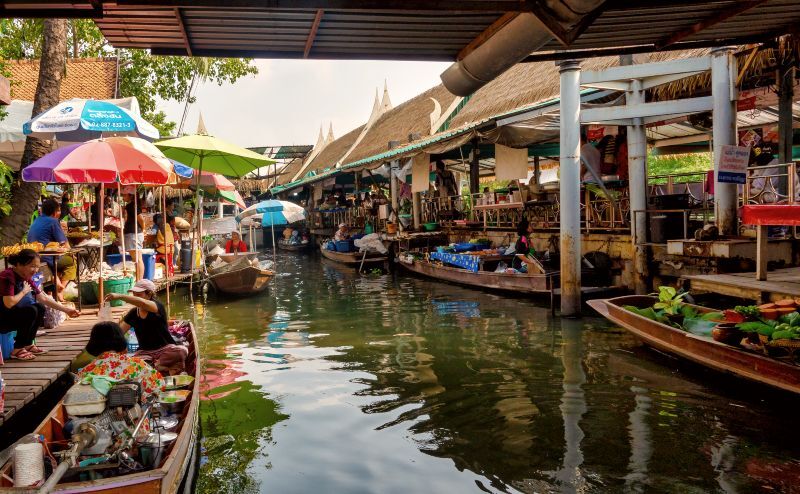
What makes Taling Chan special is its intimate, neighborhood feel. Unlike the larger tourist markets, here you’ll find Bangkok residents starting their weekend with boat noodles for breakfast or picking up fresh vegetables for the week ahead. The market spreads along both sides of a narrow canal, with simple wooden platforms extending over the water where you can sit and enjoy local specialties.
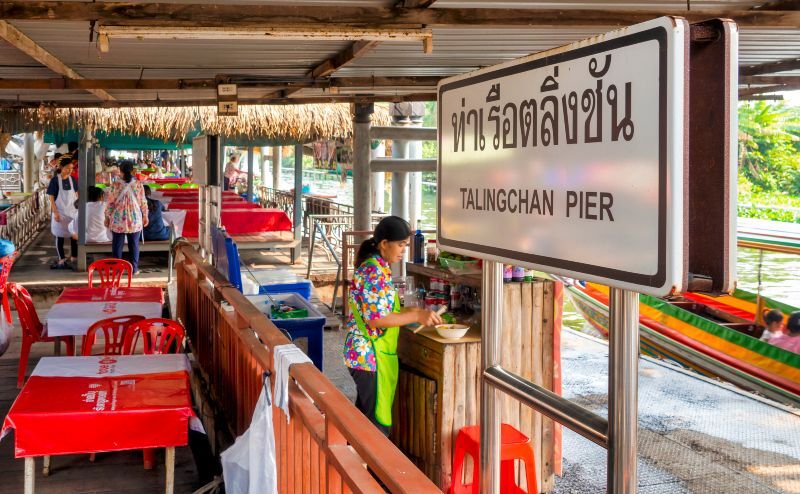
What You Need to Know
When: Weekends only, 7:30am to 5pm. Pro tip: Come early for the best selection of fresh food and a more peaceful atmosphere.
Where: 333 Chak Phra Rd, Khlong Chak Phra, Taling Chan, Bangkok 10170, Thailand (map)
How to Get There:
- Chao Phraya Express Boat to Wat Chalo pier + short walk
- Taxi or Grab (25 minutes from central Bangkok)
- Bus 79 from CentralWorld (budget option, about 1 hour)
Bonus Experience: Consider combining your visit with a traditional long-tail boat tour of the local canals – it’s a great way to see the neighborhood’s waterside life.
Bang Nam PhueBang Nam Phueng: The Market in Bangkok’s Green Lung
Hidden away on Bang Krachao Island – known as the ‘Green Lung of Bangkok’ – lies one of the city’s most unique floating markets. This 16-square-kilometer man-made island feels worlds away from the concrete jungle of central Bangkok, offering a peaceful escape where nature still rules.
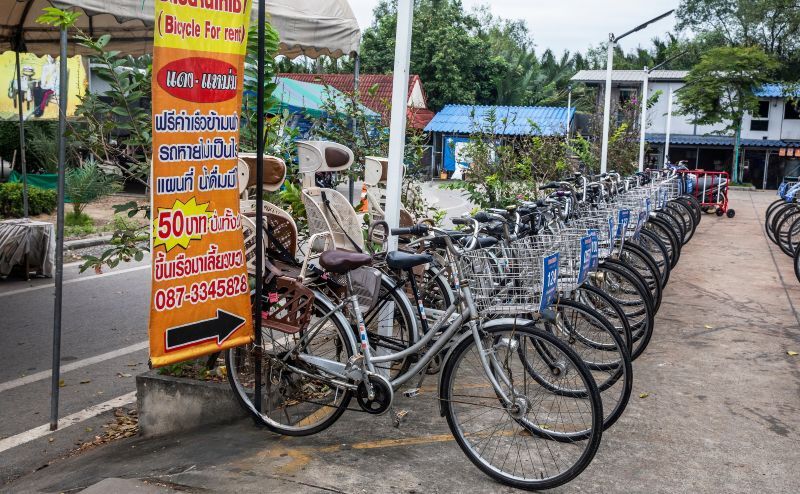
The Bang Nam Phueng market here offers a uniquely local experience. Unlike the tourist-focused markets, this one primarily serves the island’s residents. Vendors set up along the waterways and in the surrounding gardens, creating an atmospheric blend of market and park. You’ll find everything from traditional Thai breakfast dishes to local handicrafts and organic produce from the island’s own gardens.
The real charm lies in how the market fits into the island’s peaceful rhythm. Locals arrive by boat to sell fresh produce, while others cycle in from nearby neighborhoods. Find a spot at one of the waterside restaurants, try some local specialties, and watch daily life unfold on Bangkok’s last great green space.
What You Need to Know
When: Weekends from 8am to 4pm. Pro tip: Arrive early (before 9am) to enjoy the cooler morning air and watch the market come to life.
Where: 98 Bang Nam Phueng, Phra Pradaeng District, Samut Prakan 10130, Thailand (map)
How: Your options include:
- Take a ferry from Khlong Toei Pier (most atmospheric option)
- Grab taxi (about 23km from central Bangkok)
- Join a guided tour (includes transport and local insights)
Bonus Experience: Rent a bicycle at the pier (around 100 baht) to explore the island’s elevated cycling paths and hidden temples after your market visit.
Tha Kha Floating Market
Deep in Samut Songkhram Province lies Tha Kha, one of the most authentic floating markets you’ll find near Bangkok. While smaller than it once was, this market offers something rare: a genuine peek into rural Thai life where waterways still shape daily routines.
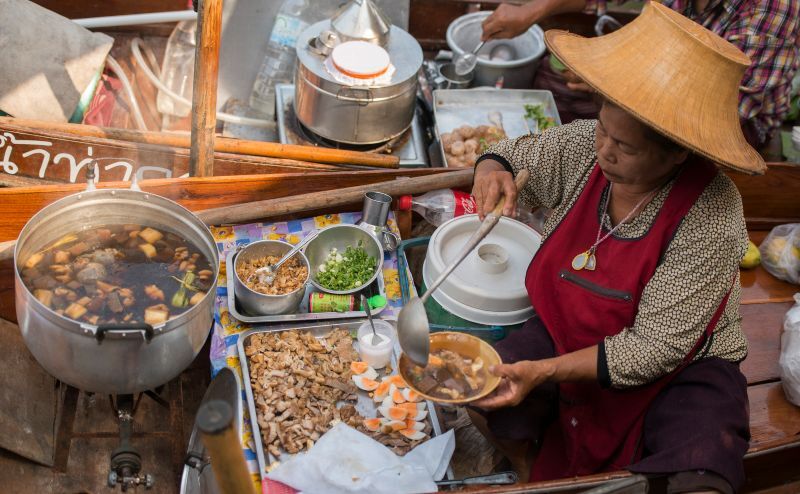
What makes Tha Kha special is its simplicity. Here, you won’t find souvenir stalls or tourist boats – instead, you’ll see farmers selling fresh produce from their gardens, locals making palm sugar the traditional way, and small boats laden with tropical fruits navigating the narrow canals.
For the adventurous traveler, Tha Kha offers a unique opportunity: you can hire a local paddleboat and explore the surrounding villages and fruit orchards.
It’s just 10km from Amphawa, making it perfect for combining both markets in one day – start at Tha Kha for a taste of local life, then head to Amphawa for dinner and evening activities.
You can even hire a boat and paddle around the village and the fruit orchards.
What You Need to Know
When: Open weekends from 6am to 2pm, plus additional days following the lunar calendar. Pro tip: Weekend mornings are most reliable for visitors.
Where: Tha Kha, Amphawa District, Samut Songkhram 75110, Thailand (map)
How: Your options include:
- Book a guided half-day tour (includes cultural insights)
- Hire a private driver (80km from Bangkok)
- Combine with Amphawa (just 10km away) for a full day of market experiences
Bonus Experience: Rent a paddleboat (around 100 baht per hour) to explore the surrounding canals and fruit orchards – the best way to see local village life.
This half-day tour includes a stop at Tha Kha and a chance to learn about the traditional Thai lifestyle and culture from your guide.
Bang Phli: Bangkok’s Oldest Surviving Market
Just south of Bangkok in Samut Prakan province, you’ll find a delightful surprise: Bang Phli Market, a 200-year-old marketplace that’s been trading since before Bangkok had its first shopping mall.
Originally called Sirisophon Market, it’s the only traditional market building in the area that survived the passage of time, keeping its original wooden charm intact.
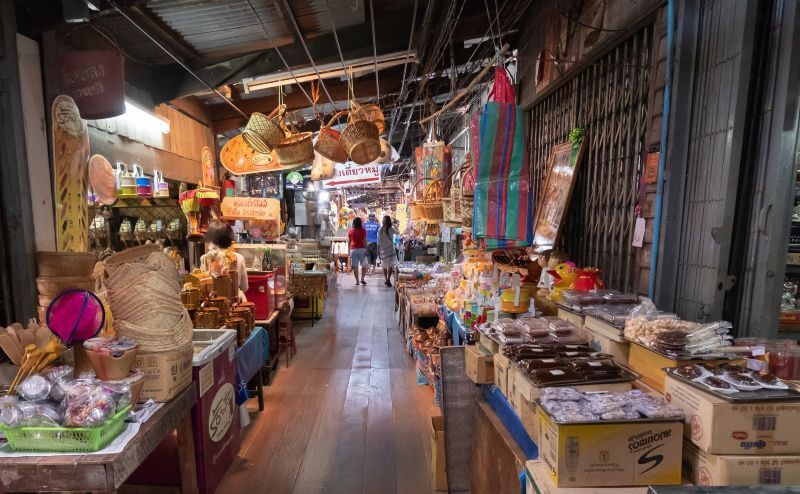
While you won’t find boats selling goods in the canal here, the market’s relationship with the water is still very much alive. The old wooden shophouses line the waterway, and getting here by boat is half the fun. Inside, you’ll find everything from traditional Thai sweets made from century-old recipes to local coffee shops where regulars have been meeting for their morning brew for decades.
What makes Bang Phli special is how little it’s changed. While modern Bangkok races ahead with new malls and skyscrapers, this little market keeps doing what it’s always done – bringing people together over good food and conversation. It’s like finding a perfectly preserved slice of old Thailand, complete with creaking wooden floors and the smell of traditional Thai coffee in the air..
What You Need to Know
When: Daily from 8am to 4pm (except holidays). Pro tip: Visit on weekday mornings to see the market at its most authentic, when locals do their shopping.
Where: Bang Phli Yai Market, Bang Phli District, Samut Prakan 10540, Thailand (map)
How: Your options include:
- Take a boat from behind Big C Bang Phli (most fun way)
- Grab taxi (about 30 minutes from Suvarnabhumi Airport)
- Public bus from Bangkok (budget option, but takes longer)
Bonus Experience: Try the local specialty ‘Khanom Wan’ (traditional Thai sweets) – some shops here have been making them the same way for generations.
How to Choose the Right Floating Market Tour
After years of taking friends and family to these markets, I’ve learned a thing or two about tours. Here’s what you need to know to pick the right one for you:
Popular Tour Combinations
The most common tours head to Damnoen Saduak, often combined with the famous Railway Market (where vendors quickly pack up their stalls as trains pass through). This combination works perfectly – you’ll see two of Thailand’s most unique markets in one day.
What to Expect on a Tour
Most tours follow a similar pattern:
- Early morning pickup (usually 7-8am)
- 1.5 hours travel each way
- 3-4 hours at the markets
- Return to Bangkok by mid-afternoon
Pro tip: The early start is worth it – you’ll arrive at the markets when they’re most active and before the heat of the day.
Choosing Between Different Tour Types
Having tried various tours over the years, here’s my insider guide to picking the right one:
Standard Group Tours
- Most affordable option
- Air-conditioned minivan transport
- Basic English-speaking guide
- Includes essential experiences
- Watch out for: Unexpected shopping stops that eat into your market time
Premium Private Tours
My top recommendation is a private market tour because:
- Faster car transport (saves about an hour round trip)
- Flexible timing at each stop
- Personal guide attention
- No unwanted shopping stops
- Worth the extra cost for a better experience
Specialty Tours
For something different, try this cycling tour in Ratchaburi Province. You’ll:
- Visit local farms
- See the countryside
- Get off the typical tourist path
- Experience rural Thai life
My Tour Tips: What to Book and What to Avoid
After trying various combinations, here’s what I’ve learned:
Best Tour Combinations
✓ Damnoen Saduak + Railway Market
- Perfect half-day combination
- Complementary experiences
- Efficient use of travel time
- Both markets are in the same direction
Combinations to Avoid
✗ Damnoen Saduak + Ayutthaya
- Different directions = too much travel time
- Rushes both experiences
- Ayutthaya deserves its own day
✗ One-day Market + Kanchanaburi combo
- Too rushed for Kanchanaburi’s many sites
- Better to spend 2-3 days in Kanchanaburi separately
My Top Tour Picks
- For First-Timers: Half-day Damnoen Saduak + Railway Market
- For Photography Enthusiasts: Early morning private tour
- For Culture Lovers: Full-day tour with local village visits
Want something different? See the full range of floating market tours here.
What to Buy at Bangkok’s Floating Markets
The floating markets are a feast for all your senses, but it’s your taste buds that will thank you most. Each market has its own specialties, but there’s one dish you absolutely must try: boat noodles. These small bowls of rich, aromatic soup tell the story of life on the water – originally served from boat to boat, they’re still made using recipes passed down through generations.
The markets really shine when it comes to seafood. Vendors grill fresh river prawns right on their boats, the smell of salt-crusted fish mixing with the river breeze.
There’s something special about eating seafood just steps from where it was caught, especially when it’s prepared with traditional Thai spices and techniques.
During mango season (April to June), the fragrant yellow fruit is paired with sweet sticky rice and coconut cream – it’s heaven in a banana leaf. Don’t miss the coconut ice cream served in freshly husked coconuts, or watching skilled vendors create traditional Thai sweets using recipes that haven’t changed in centuries.
Fresh river prawns, salt crusted grilled fish, mango sticky rice, pork satay, BBQ grilled chicken, Thai noodles and almost any other street food you’ve heard of can be found at one or more floating market in Bangkok.
What to Expect: Costs and Etiquette
One of the best things about floating markets is that they’re incredibly accessible – none charge an entry fee. You might need to pay a small amount (usually 100-200 baht) for a boat ride into the heart of the market, but it’s worth every baht for the experience.
Your main expenses will be:
- Getting there (whether by tour, taxi, or public transport)
- Boat rides within the market
- Food and shopping
Here’s a tip from someone who’s been countless times: while it’s tempting to just take photos, remember these markets are still a vital part of many families’ livelihoods. Try the local specialties, buy some fresh fruit, or pick up a handmade craft. Even a small purchase helps keep these historic markets alive and supports the local community that makes them so special.
Making the Most of Your Floating Market Visit
- If you’re after that classic floating market photo opportunity, Damnoen Saduak is your best bet. Yes, it’s touristy, but those iconic scenes of boats laden with tropical fruits and elderly vendors in traditional hats? This is where you’ll find them. Go early to beat both the crowds and the heat.
- For a more authentic evening experience, head to Amphawa. The sunset here is magical, and the seafood dinner options are incredible. Better yet, make it an overnight trip and catch the firefly boat tour – it’s a side of Bangkok most tourists never see.
- Short on time but still want the experience? Taling Chan brings the floating market atmosphere right to Bangkok’s doorstep. It’s perfect for a half-day adventure, especially if you combine it with a local canal tour.
- For those seeking something more off the beaten path, I have two recommendations: Bang Nam Phueng on Bangkok’s green lung offers a peaceful, local vibe with excellent food, while Tha Kha gives you a glimpse of rural Thai life that feels worlds away from the city.
- And if you’re a history buff, don’t miss Bang Phli – it’s like stepping back in time, with its 200-year-old wooden architecture and traditional Thai sweets made the same way for generations.
Final Tips
- Visit early morning or late afternoon to avoid the heat
- Bring cash (small bills are best)
- Be open to trying new foods and experiences
- Take time to chat with the vendors – many have been here for decades and have fascinating stories to share
Remember, these markets are more than just tourist attractions – they’re living pieces of Thai culture. Each visit helps keep this beautiful tradition alive for future generations to enjoy.
Want more markets? Check out our guide to Bangkok’s best night markets. Heading to Phuket, this guide to Phuket’s island’s markets is a must read. Some of our favourite markets are in Hua Hin so add those to your list too. For some of the best markets in all of Thailand, Chiang Mai markets will not disappoint.
Ready to start planning your Thailand trip? Our Facebook community Thailand Awaits is here to help. Join fellow travellers, get your questions answered by Thailand experts, and access free planning resources.
